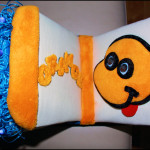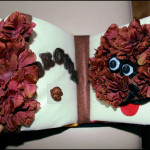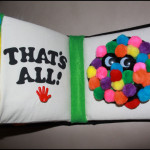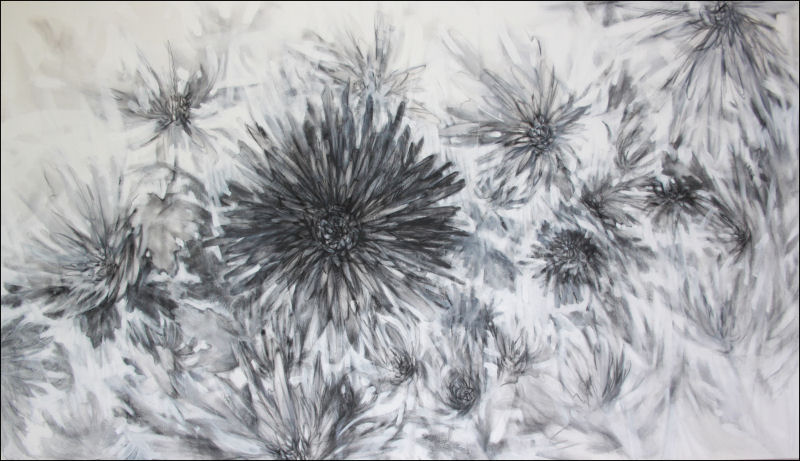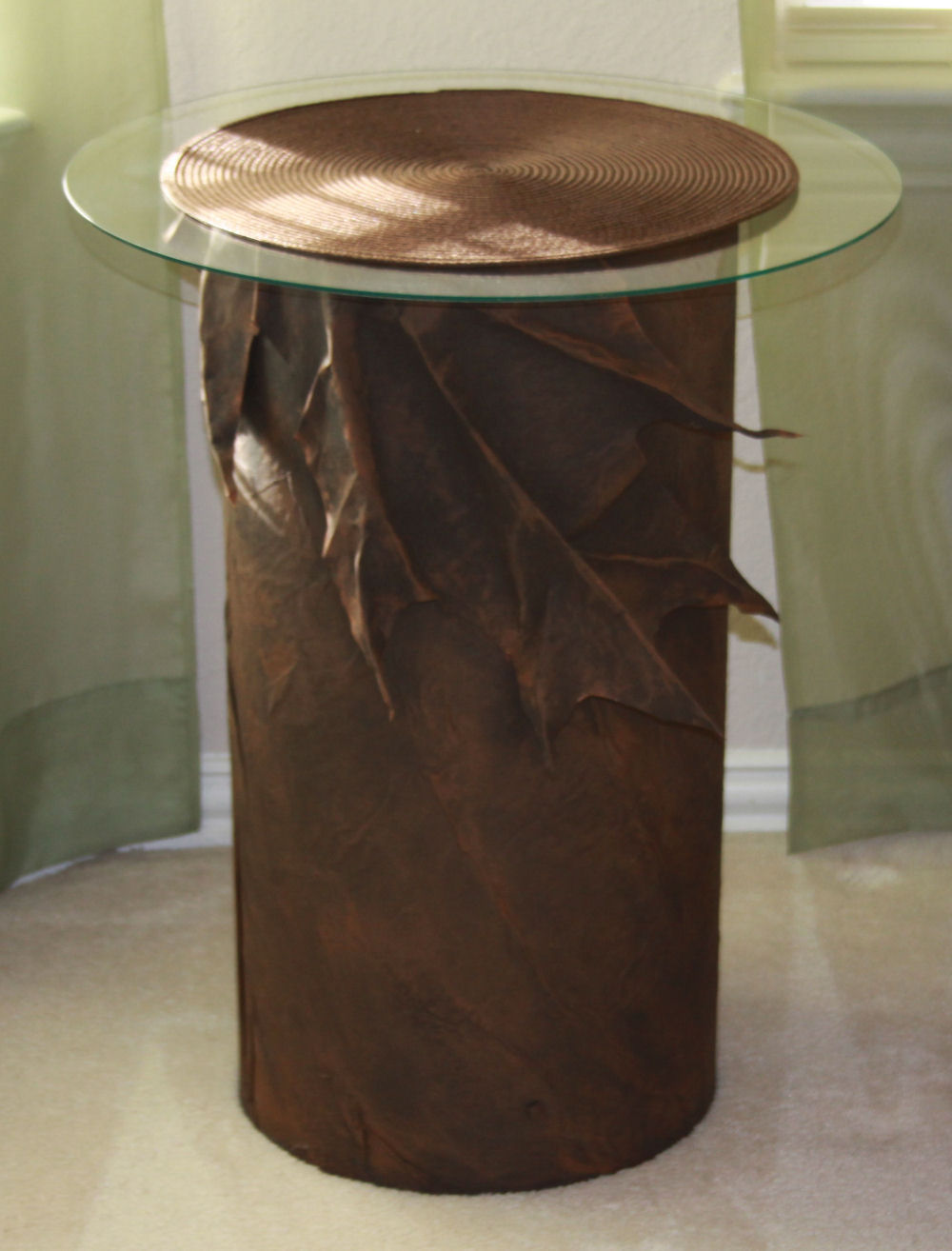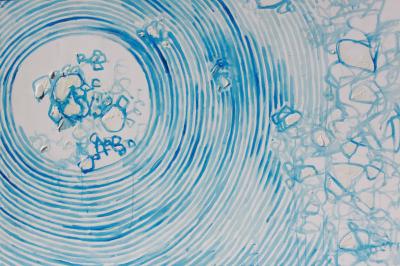design
« Previous Entries Next Entries »Colours For Cameron, first book for my grandson
Friday, May 25th, 2012
When my grandson was born in 2011, I had already decided to make him a book every year for his birthday. One-year-olds are receptive to colors and textures, so a soft book for Cameron at this age was perfect. Using Monte as my muse, the work evolved into a sort of stuffed toy-book hybrid that is much bigger than was initially planned, but it’s quirky, fun to read, and Cameron likes it. Each 6 x 6 inch page is quilted unbleached cotton sewn over heavy cardboard from a disassembled book purchased at the dollar store. I bought a lot of the things there actually, like many of the textured materials, including a dog toy with the squeaker removed and incorporated into the last page. The savings were spent on tractor buttons and more costly embellishments I knew he would like.
 Each page has quilted appliques of Monte in different colors, with big googly eyes. The outer edges of each page have shallow pockets to grab the page, covered whatever textile corresponds to each Monte. The ten or so chubby pages are sewn together – 2 inches of fabric were left on the book’s spine-side for that purpose. The combination was then attached to a sturdy cardboard spine with a glue gun. No turning back after that, because hot glue is permanent on fabric. The entire cover of black linen wraps around with straps that Velcro together, creating a handle. Little button-vehicles adorn the handle area – he loves tractors and cars. I’m happy with the finished piece, and so is Cameron. It’s one of a kind, like him.
Each page has quilted appliques of Monte in different colors, with big googly eyes. The outer edges of each page have shallow pockets to grab the page, covered whatever textile corresponds to each Monte. The ten or so chubby pages are sewn together – 2 inches of fabric were left on the book’s spine-side for that purpose. The combination was then attached to a sturdy cardboard spine with a glue gun. No turning back after that, because hot glue is permanent on fabric. The entire cover of black linen wraps around with straps that Velcro together, creating a handle. Little button-vehicles adorn the handle area – he loves tractors and cars. I’m happy with the finished piece, and so is Cameron. It’s one of a kind, like him.
Chrysanthemums: work in progress
Friday, May 18th, 2012
Chrysanthemums, 45L x 85W x 3D inches, graphite, charcoal and primer on 100% cotton, work in progress
 Rather than priming the fabric first as usual, water and primer are painted to enhance the graphite while the composition works itself out. It’s been all about getting lost in the improvisation and surprise! Grass blades are implied by the buildup of thin streaks throughout, which also serve to balance and energize the work, plus add slight cubist effects.
Rather than priming the fabric first as usual, water and primer are painted to enhance the graphite while the composition works itself out. It’s been all about getting lost in the improvisation and surprise! Grass blades are implied by the buildup of thin streaks throughout, which also serve to balance and energize the work, plus add slight cubist effects.
This is will hang in a contemporary-style room. If color is used at all it will be limited to red, yellow and green areas near the large main flower. Parts of the surface may be left raw, so to set the finished piece, the entire back will be primed and the front will be sprayed with fixative.
~
The chaos of this past year, moving to Oregon from Texas, has truly put my artsy artist’s statement to the test; that ‘creativity is an attitude toward life’. I’m accustomed to creating chaos in my artwork, then resolving it. With too many move-related priorities and unfinished renovations, no wonder I’ve felt increasingly disoriented. The good thing is that observations never stop, even if the focus on art-work has to.
Monte rocks!
Tuesday, May 10th, 2011
Monte rocks! Who is he?
Stepping Stones
Friday, March 25th, 2011
While I was in Portland two weeks ago, starting the Texas-Oregon relocation process, I completed five new Zen Gardens, filling a request for one. All five are smaller, slightly different versions of ones made previously. Four are shown in thumbnail images below.
The very first Zen Garden was created in 2000 as part of a four-painting commission. The ideas established in that set foreshadowed new routes to trying methods I hadn’t before, like enhancing my paintings with 3D elements. That set is also the origins of the “box frame” design that I’ve used on several other paintings since then, where each main canvas is mounted on a wood platform, framing the work with about four inches of extra play-space.
Whereas some frames have the effect of abruptly ending a composition, this type of frame enables space for the subject to continue, softens the edges and adds an interesting twist to the overall impression. When items related to the main subject are placed in that area it adds dimension, not just in the physical sense, but also in the conveying of any abstract or symbolic stories beyond the presentation of the main painting inside.
Because of the challenges acheived in those paintings, 1) a series was born that I’ll continue with for the rest of my days. In  2) Prickly Pear Cactus, pins were applied around the main central frame, then painted. The smaller canvas done during 2005 (left) borrowed this technique, and the same principle of attaching things to the main frame can be used with any number of objects.
2) Prickly Pear Cactus, pins were applied around the main central frame, then painted. The smaller canvas done during 2005 (left) borrowed this technique, and the same principle of attaching things to the main frame can be used with any number of objects.
In 3) Alpine Meadows, I learned to use all the qualities acrylic paints offer by watering down the consistency for the distant mountains, then sculpted the flowers and grasses with a palette knife on the lower portion. Finally, the theme of 4), The Evolution of Communication has intrigued me ever since, but I still haven’t fully pursued the possibilities. This is the perfect means to learn about Art History hands-on by attempting to recreate it in some form, then to share that adventure and ideally, inspire interest in the topic at the same time. Two old keyboards have been collecting dust in my studio closet for a number of years, yet to be disassembled and incorporated into a new series of work with similar associations.
~
Some of our peers advocate that if we don’t concentrate our efforts to learn one medium well, we will never excel in any. They are right of course, in many respects, but scores of artists are not content with singing just one note. Some simply cannot. To be fair, what works for one does not work for another. Each of the above paintings are examples where a combination of skills and different media in one piece can be very effective. I’m here to say that integration is possible! It’s a longer, meandering road..but it is possible.
 There are so many different paths artists can take, long and short term; opportunities every day. There are endless kinds of subjects, ready-made and unconventional materials, always something to start or finish, new methods to explore, and an overabundance of ideas to attempt in one lifetime. Self discipline is the order of every day, either to start working or know when to stop.
There are so many different paths artists can take, long and short term; opportunities every day. There are endless kinds of subjects, ready-made and unconventional materials, always something to start or finish, new methods to explore, and an overabundance of ideas to attempt in one lifetime. Self discipline is the order of every day, either to start working or know when to stop.
My philosophy is that doing something, unless naturally in need of rest, is better than doing nothing. However, being overly ambitious in too many areas is also how I, along with millions of other artists end up with a variety of different kinds of art (or just stuff!), and the arguements endorsing one type of study come into play. Should we restrain ourselves when it comes to making “stuff”? Why is consistency given more support than variety when it comes to showing and selling art?
Whatever choices we make; whichever direction we take depends mostly on the intention for the finished products. Who is it for, do you want it to sell it, where, how, and how quickly? Was work done as a personally cathartic process, as a lot of art is? …or is it just a thing with no emotional attachments or brainy messages? Artists who support themselves by offering a range of services, satisfied and busy enough by word-of-mouth sales, do well jumping from medium to medium. If the hope is selling work through galleries and art dealers though, what some call “too many voices” are apt to be a disadvantage. 
In one of his recent articles, Robert Genn writes sensitively about multi-media artists. While he supports that “for artists, exploration is like oxygen” and that “the nature of our game is to be distracted by our muse”, he also recommends that artists must present consistency in our approach if gallery exhibition/sales is what we pursue.
When a gallery represents an artist, they expect an overall consistent look and a clear statement. Where venues sell a number of artists’ work, the ambiance cannot be one that resembles a yard sale. If potential buyers view too many styles, subjects or media in one place or by one artist, they tend to lose interest, resort to window shopping, and walk away empty-handed.
 I can relate to that: the effect is like standing in the toothpaste isle at the pharmacy, where the senses are bombarded with colorful packaging, alluring titles and fine-print promises. Assuming beforehand that the choice would not be anything but simple, there have been times when I’ve said ‘forget it’ and gone back another day. With art sales though, you don’t want buyers to come back another day, because it may not be your art they choose then.
I can relate to that: the effect is like standing in the toothpaste isle at the pharmacy, where the senses are bombarded with colorful packaging, alluring titles and fine-print promises. Assuming beforehand that the choice would not be anything but simple, there have been times when I’ve said ‘forget it’ and gone back another day. With art sales though, you don’t want buyers to come back another day, because it may not be your art they choose then.
Gallery owners and dealers do not do us any favor if they display too much variety in typically limited spaces, so Mr. Genn has an excellent suggestion: bring art done in different medias to different galleries.
He also says to keep working no matter what.
Artists have a strong sense of mission. Periodically it needs reevaluation, and with that bigger picture clear, we create the way as it unfolds before us. If we are serious about selling, we first need to become familiar with what we are best at, what we love, what works and what doesn’t. We need experience in order to learn – that takes time – and there’s no getting around it. Experimentation is fundamental to this profession, but if it’s intended to be sold to others and by others, simplifying the look and clarifying the purpose of our art is crucial.
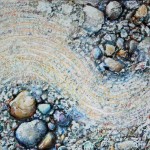 A viewer at one of my exhibitions commented, “You’re all over the place, arentcha?!” As disturbing as that was, it’s true and I needed to hear it, eventually concluding that I do need to clean up my act, but at the same time this is how I work. This is how my stuff works. Every so often there are paintings or a series of works that encompass all that’s been learned and all that I’m capable of; breakthroughs that define a solid new direction or validate the existing one. The commissioned set of paintings described above were like that, and their significance is still an influence on today’s work and will be on tomorrows’ too. They verified that I’m on the right path even though much of the time is spent off of it, experimenting. I call it serious play and paying attention… “playing attention”! Once in a while the bits and pieces come together in one big rewarding “Eureka!”.
A viewer at one of my exhibitions commented, “You’re all over the place, arentcha?!” As disturbing as that was, it’s true and I needed to hear it, eventually concluding that I do need to clean up my act, but at the same time this is how I work. This is how my stuff works. Every so often there are paintings or a series of works that encompass all that’s been learned and all that I’m capable of; breakthroughs that define a solid new direction or validate the existing one. The commissioned set of paintings described above were like that, and their significance is still an influence on today’s work and will be on tomorrows’ too. They verified that I’m on the right path even though much of the time is spent off of it, experimenting. I call it serious play and paying attention… “playing attention”! Once in a while the bits and pieces come together in one big rewarding “Eureka!”.
Art and Adaptation
Saturday, February 12th, 2011
Adapt “1a: to make suitable or fit (as for a particular use, purpose, or situation) 2: to adjust oneself to particular conditions or ways: bring oneself or especially one’s acts, behaviour, or mental state into harmony with changed conditions or environment.”
Art “1b(1): skill in the adaptation of things in the natural world to the uses of human life … 2d: systematic application of knowledge or skill in effecting a desired result … and to production according to aesthetic principles…” (Webster’s Third New International Dictionary).
 Art is all about adaptation – of materials to circumstances, to changes in initial plans and set expectations, and staying open to the serendipity of the inevitable unknown in order to recognize opportunities when they unfold as mistakes. A painting goes through alternating stages of chaos and resolve, of full-on confident energy intermittent with periods of reservation and study. One never knows when the process will be finished, and sometimes great efforts result in nothing great to show.
Art is all about adaptation – of materials to circumstances, to changes in initial plans and set expectations, and staying open to the serendipity of the inevitable unknown in order to recognize opportunities when they unfold as mistakes. A painting goes through alternating stages of chaos and resolve, of full-on confident energy intermittent with periods of reservation and study. One never knows when the process will be finished, and sometimes great efforts result in nothing great to show.
Adapting to life changes is very much like painting. The materials are different, but seeing it that way, moving personal and professional life to another part of the world does not seem so disruptive. That “life imitates art and art imitates life” never quite made sense to me until now. It’s about seeing the picture as a whole while manipulating sections of it, without getting so involved in the details that, ironically, the focus is lost.
All the travel last year was rejuvenating. By the time Fall arrived I was good and ready to apply those experiences to some dedicated painting when, during September my husband accepted a job in Oregon. As folks who know us know, he moved there in October while I stayed behind. With all this attention to house-duty, I’ve been feeling anxious about not being able to maintain all my career commitments during this transition. After not posting any new art on this blog for about six weeks, it’s important to my reputation as a professional that clients and associates (past, present and future) know that I have not stopped working; only have briefly been working on something else.
 I’m looking forward to the drive from Texas to Oregon; one phase completed and another beginning. Regardless of location, ideas and inspirations are infinite, always available and uninterrupted in the grand scheme of things. Best of all, these things are portable! You can take the girl away from the art, but you can’t take the art away from the girl!
I’m looking forward to the drive from Texas to Oregon; one phase completed and another beginning. Regardless of location, ideas and inspirations are infinite, always available and uninterrupted in the grand scheme of things. Best of all, these things are portable! You can take the girl away from the art, but you can’t take the art away from the girl!
Saying that change is good sounds cliche, but here’s how I think it works: change pushes us into discomfort, which in turn pushes us to seek innovative ways out in order to regain comfort. In that sense, discomfort is motivating and progressive. Now that I think of it, too much comfort can be uncomfortable! When one set of dilemmas is resolved we instinctually go searching for more. Life and Art are a soul’s song and dance.
Above: Basil roots and stems garden sculpture entitled “Song and Dance”
Practical design
Tuesday, December 21st, 2010
“Necessity is the mother of invention.”
Aesop’s Fables
Oak Leaf bedside tables, 24H x 12W inches with a 20-inch glass top. Large, crinkled paper mâché leaf-shapes are creased, folded and arranged over the top of heavy cardboard tubes. The tubes are available in a variety of dimensions, sold in hardware stores as use for cement foundations.
I’ve had this idea to make bedside tables for a few years now, and selling the house, prepping it in a minimalist way for viewing has motivated me to finally make them. Faux suede effects were the intention here, and I’m pleased with the results. it really does look like suede. A brown circular woven mat covers the glass and hides the space looking into the tube.
Zen Garden #10 almost finished
Wednesday, November 10th, 2010
Zen Garden 10, 40 x 60 x 3 inches mixed media on canvas.
The final stages of this paintings will be finished as it hangs on a wall. As seen in a realistic room setting, it will be easier to spot whatever might make the composition more interesting. Some colors may need to be re-enhanced to add more depth and definition, but I also like the overall faded look, so we’ll see. The texture continues around all 3D edges. This painting is extremely heavy, as it is on a home-built canvas stretcher, so it will be transferred onto a lighter-weight stretcher if it sells. It will still be stable, but practical. All paintings in the Zen Garden series are wired to hang in any of 4 orientations: vertically or horizontally. Below: details of left central portion as seen in the above.
Zen Garden #09 and #10
Tuesday, November 2nd, 2010
Zen Garden 09 work in progress, 48 x 21 x 2 inches mixed media on canvas
The perfect painting in a room can elevate the atmosphere of the whole floor, and sets the tone for showing off the entire house. With selling the house in mind, I’m trying to choose a decent painting for our living room, because Zen Garden 02 sold, so I decided it’s worthwhile to make two more for the series.
Zen Garden 10 outline, 40 x 60 x 3 inches Mixed Media on canvas
Painting is always meditative, but I find it especially so when creating pieces in the Zen Garden series. This kind of work does not present the same kind of emotional concentration or intellectual challenges that other paintings do. There are few struggles and hardly any decisions to make, except to find cooperative materials. Once the outline is accomplished it’s pretty straightforward compared to other forms of painting. The outstanding difference is that each stage in these 3D paintings requires time and patience to allow areas to dry before proceeding. The Zen Gardens can be drying in stages while other work gets done too, and the multi-tasker in me is quite happy to be accomplishing many things at once!
 Art supplies are expensive. Most will last long enough to justify purchases, and much of the time you get what you pay for, but some items are ridiculously overpriced. Keeping material costs down is essential so they aren’t reflected in the final price, but quality should never be compromised. Still, there are ways to get around any dilemma, and there are alternatives for everything.
Art supplies are expensive. Most will last long enough to justify purchases, and much of the time you get what you pay for, but some items are ridiculously overpriced. Keeping material costs down is essential so they aren’t reflected in the final price, but quality should never be compromised. Still, there are ways to get around any dilemma, and there are alternatives for everything.
When I started the Zen Garden series ten years ago using modeling paste and textured gels, jars were about $15 for 250 ml. Since then I’ve experimented with various unusual materials, and shopped everywhere to compare prices. It’s still more economical to purchase brand-name products in larger quantities – if you can find them. There are some fun mediums available now too, like gel with tiny glass beads in it. Prices for art supplies do not seem to waver over time in either Canada or the U.S., so I reserve the brand-name mediums to sculpt the rocks and highest quality paints do the finishing touches. Here I’ll share a few of the trade secrets I’ve discovered over the years, and you can create your own Zen garden painting.
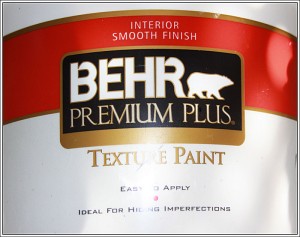 As a base for the raked sand mixture, it’s worth purchasing a large 2 gallon (7.58 L) pail of textured paint. I purchased Behrs at Home Depot in Canada, and it looks like Ralph Loren has the market cornered in the States. Watered-down drywall plaster can be used also, but I recommend attention to how heavy the piece may be when it’s finished. Mix in copious quantities of white glue, large containers of white or light-colored acrylic craft paints, and anything water-based that will extend the liquid mixture and bind well with the dry ingredients. Sand, even popcorn kernals and/or rice can be added for texture. Other objects can be incorporated too…just use your imagination. For example, and this is my most valuable secret, unscented kitty litter from the dollar store, the non-absorbant kind, looks exactly like tiny stones and is light in weight.
As a base for the raked sand mixture, it’s worth purchasing a large 2 gallon (7.58 L) pail of textured paint. I purchased Behrs at Home Depot in Canada, and it looks like Ralph Loren has the market cornered in the States. Watered-down drywall plaster can be used also, but I recommend attention to how heavy the piece may be when it’s finished. Mix in copious quantities of white glue, large containers of white or light-colored acrylic craft paints, and anything water-based that will extend the liquid mixture and bind well with the dry ingredients. Sand, even popcorn kernals and/or rice can be added for texture. Other objects can be incorporated too…just use your imagination. For example, and this is my most valuable secret, unscented kitty litter from the dollar store, the non-absorbant kind, looks exactly like tiny stones and is light in weight.
Zen Garden 09 details: applying mixture with a knife, sculpting rows
 The mixture can be put in a ziplock bag with one corner cut out, but I discovered that it’s more efficient – however messy – to spread small portions out onto the surface with a knife and hand-mold it. Keep a wet cloth handy to wipe your hands and the utensil often.
The mixture can be put in a ziplock bag with one corner cut out, but I discovered that it’s more efficient – however messy – to spread small portions out onto the surface with a knife and hand-mold it. Keep a wet cloth handy to wipe your hands and the utensil often.
Drywall plaster makes nice-looking rocks, plus it cracks well for a parched-earth look, use sparingly because of added weight. Wood filler is a lighter alternative, much less expensive than professional brand gels and mediums. Modeling pastes do not lend well to sanding or carving when dry, but wood filler can be sanded and re-shaped.  Also, if it dries out completely, chop it up, add water then seal the container for a day or so. This is where you can experiment with whatever helps acheive 3D effects. Art, craft, hardware, department stores and dollar stores carry generic brand basics, so it’s worth researching and shopping around.
Also, if it dries out completely, chop it up, add water then seal the container for a day or so. This is where you can experiment with whatever helps acheive 3D effects. Art, craft, hardware, department stores and dollar stores carry generic brand basics, so it’s worth researching and shopping around.
When it’s all dry, rocks and other details are outlined and painted with pure colors, then all covered with a coat of primer. The colors are all reapplied to further enhance rocks, then brushed white, skimming across the entire surface. This process is repeated until you are pleased with the results by a final coat of white with remnants of the layers of colors poking through underneath. As far as acrylic paints, you do get what you pay for, but price differences are mostly due to pigment quality and viscosity, which, until final stages is not really an issue. Inexpensive acrylic craft paints are perfect as a filler (only).
 Zen Garden #10, above and left is already quite heavy, so about 1/4 of it will be painted rocks, keeping the sand patterns to a minimum. There is enough mixture that could dry out if it’s not used right away, plus it’s great to make multiples while all the mess, materials and utensils and are out, so I’m doing two simultaneously. There may even be enough for 3!
Zen Garden #10, above and left is already quite heavy, so about 1/4 of it will be painted rocks, keeping the sand patterns to a minimum. There is enough mixture that could dry out if it’s not used right away, plus it’s great to make multiples while all the mess, materials and utensils and are out, so I’m doing two simultaneously. There may even be enough for 3!
The necessity of work, especially if it’s at home, seems less like a chore if you dangle some kind of carrot for yourself every day. Sometimes having too much to do is more exhilarating than exhausting. Each day, though work as an artist can be considered by others as play, the energy, motivation and circumstances are unpredictable.. It takes self-discipline to find a way to go with the flow and still get work done. The good thing about this occupation is that it is flexible in every way. The creative compulsion seeps into every other activity, and there is almost no way to not add a little something extra.
Summer travels
Friday, August 13th, 2010
When I’m back in Dallas blogging regularly again, these photos will be posted on the photography website. An unplanned extra trip from Alberta to Ottawa; in Ontario a second time, means I won’t be back until the first week of Sept. Here are a few photos I took on the shores of Lake Superior just east of Wawa, ON.
Support Your Artists
Tuesday, May 11th, 2010
Support Your Artists slogan, design copyright nikkiartwork 2008, decals available.
« Previous Entries Next Entries »








